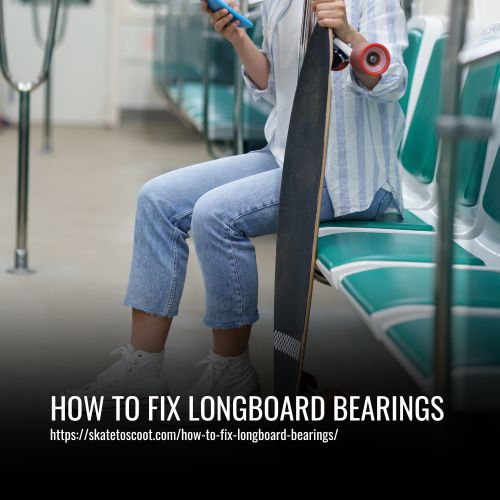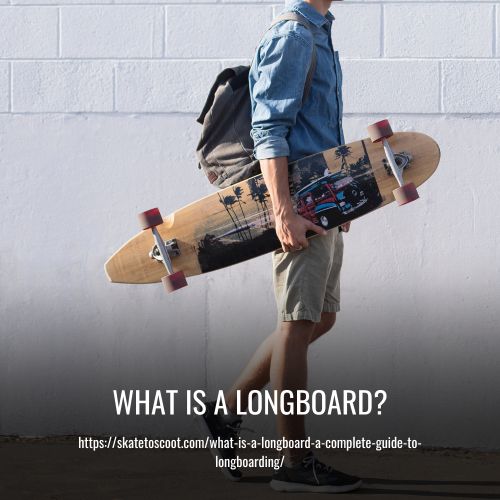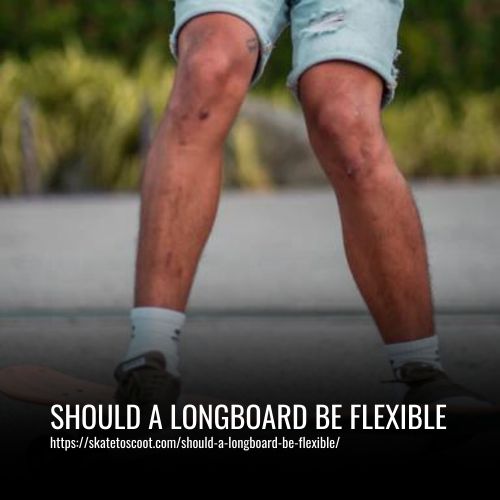As an Amazon Associate we earn from qualifying purchases.
Are your longboard bearings making strange noises and slowing you down? Don’t worry, you don’t have to replace your entire longboard just yet. With a little bit of know-how and the right tools, you can easily fix your longboard bearings and get back to cruising smoothly.
Longboard bearings are an essential component of a smooth ride, but they can wear out over time or become dirty and clogged with debris. However, you don’t need to be a professional Longboard to fix them. In this article, I’ll walk you through the steps to fix your longboard bearings and get them spinning like new again.
So, if you’re ready to save some money and get your longboard back in top shape, let’s dive into the world of longboard bearing maintenance and repair.

How To Fix your longboard bearings, follow these simple steps:
- Remove any visible dirt or debris: Use a paper towel or clean rag to carefully wipe off any dirt or debris stuck on the bearings. This step is important to prevent the dirt from entering the innermost part of the bearings.
- Prepare a cleaning solution: In a clean bowl or basin, pour in a mild solvent such as rubbing alcohol or mineral spirits. Alternatively, you can use acetone, but be cautious and wear gloves to protect yourself from the harsh chemicals. Fill the bowl with enough solution to submerge the bearings.
- Pry off the rubber shields: Using the point of an X-acto knife, safety pin, or paper clip, gently pry out the rubber shields on the bearings. These shields are usually black or red in color. Once the shield is removed, you will see the small metal balls known as the ball bearings.
- Submerge the bearings: Place the bearings in the cleaning solution and swirl them around for approximately five minutes. Let them sit in the solution for another ten minutes to ensure thorough cleaning.
- Dry the bearings completely: After soaking, remove the bearings from the solution and dry them thoroughly using a paper towel or dry rag. Make sure to keep the bearings in a safe place to avoid misplacement.
Additional tip: To speed up the drying process, you can use canned air. Point the nozzle of the canned air into the open part of the bearings and use your fingers to move the bearings in a circular motion while spraying air.
Benefits of Fixing Longboard Bearings
Fixing longboard bearings offers a multitude of benefits that can greatly enhance your riding experience. By taking the time to clean and maintain your bearings, you can improve their overall performance and extend their lifespan.
Clean and well-maintained bearings ensure smooth and efficient rides. By removing built-up dirt and debris, you reduce friction and allow the bearings to roll more freely. This reduction in friction translates into increased speed and improved maneuverability, allowing you to glide effortlessly across any surface.
Properly fixed longboard bearings also provide a more consistent and reliable ride. Regular maintenance prevents wear and tear, ensuring that your bearings function at their optimal level. This reliability enhances your overall control and stability while riding, helping you to execute precise turns and tricks with ease.
Why Should You Fix Your Longboard Bearings?
Regularly fixing and maintaining your longboard bearings is essential for several reasons. Firstly, dirty or damaged bearings significantly impact the performance and safety of your longboard. When bearings become contaminated with dirt, dust, or debris, they generate more friction, making it harder to ride smoothly and efficiently. This can also lead to uneven wear on the bearings, reducing their lifespan and increasing the chances of unexpected failures.
Moreover, neglected bearings can negatively impact your overall riding experience. The increased friction caused by dirty or damaged bearings leads to decreased speed and poorer maneuverability. This makes it harder to execute tricks, turns, and slides with precision and control.
The Necessary Materials/tools
To fix your longboard bearings, you will need a few essential tools and materials. These include:
- Pliers/Screwdriver: A pair of pliers or a screwdriver will come in handy when removing the axle nut and wheel from the truck.
- Socket Wrench/Ratchet: You will need a socket wrench or ratchet to remove the nut that secures the bearings in the wheel.
- Skate Tool or T-Tool: A skate tool or T-tool is a versatile tool that combines various sizes of sockets and a screwdriver. It can be used to remove the nuts on your trucks and wheels.
- Bearing Pole: A bearing pole is a small rod specifically designed to help you remove bearings from the wheels.
- Cloth (2 pieces): You will need two clean pieces of cloth to wipe and dry the bearings during the cleaning process.
- Clean bowl: A clean bowl will be used to hold the cleaning solution while you soak the bearings.
- Acetone or a milder solvent: Acetone, mineral spirits, or rubbing alcohol can be used as solvents to clean the bearings. Use acetone only if you are wearing gloves and in a well-ventilated area.
- Gloves (if you use acetone): Gloves are necessary to protect your hands if you choose to use acetone as a solvent.
- X-acto knife/Paperclip: An X-acto knife or a paperclip can be used to remove built-up dirt or grime from the bearings.
- Canned air (optional): Canned air can help blow out any remaining debris or moisture from the bearings after cleaning.
By having these necessary tools and materials ready, you will be well-prepared to fix your longboard bearings and restore their performance effectively.
How to Clean Longboard Bearings
Longboard bearings are an essential part of every Longboard, as they allow the wheels to spin smoothly and efficiently. Over time, bearings can accumulate dirt, dust, and debris, leading to reduced performance and a less enjoyable ride.
1. Remove the Bearings
To remove the bearings from your longboard, you have a few options available. One method is to use a screwdriver or needle-nose pliers to carefully pry the bearings out of the wheels. Another option is to use a thick metal rod as an improvised bearing puller. Simply insert the rod into the bearing opening where the axle goes, hold the bearing on the opposite side, and tap the rod gently with a hammer to dislodge the bearing.
It’s important to note that the improvised bearing puller method may risk damaging the bearings, so proceed with caution. If possible, it’s recommended to invest in a proper bearing puller tool designed specifically for this purpose.
Remember to keep track of the smaller parts, such as nuts, washers, and bolts, that come off with the removed bearings. These parts can be easily lost, so placing them in a safe container box while working on your longboard is advisable.
2. Disassembling the Bearings
To properly fix or clean your longboard bearings, you need to disassemble them. Here’s a step-by-step guide on how to safely and efficiently disassemble your Longboard bearings:
- Remove the Bearing Shields or Covers: Start by using a skate tool or a small knife blade to carefully pry off the bearing shields or covers. If your bearings have rubber shields, gently insert a safety pin or a razor blade and lever it out. For bearings with metal shields, use the same technique to remove them. Be cautious during this step so you don’t damage the bearings.
- Take Out the Bearing Shields and Spacer: Once the shields are removed, carefully take out the bearing shields and spacer, if there is one. These are small metal rings located on each side of the bearings. Place them in a safe location to avoid misplacing them.
- Remove the Balls and Races: Flip the bearing over, so the balls and races are exposed. To remove them, hold the inner race and tap the outer race gently against a sturdy surface. This will cause the balls and races to come out. Repeat this process for all the bearings.
It’s important to handle the bearings with care during this disassembly process to prevent any damage. Now that you have successfully disassembled your longboard bearings, you can proceed with cleaning or replacing any worn-out parts.
3. Reassemble and Grease Longboard Bearings
Once you have thoroughly cleaned your Longboard bearings, it is important to reassemble them properly and apply lubricant for optimal performance. Follow these steps to reassemble and grease your Longboard bearings:
- Lubricant Application: Choose a Teflon-based lubricant specifically designed for Longboard bearings. Avoid using other oils such as motor oil or cooking oil, as they can damage your bearings. Place two or three drops of the lubricant into each bearing.
- Distribute the Lubricant: Spin the bearing to evenly distribute the lubricant inside. This will ensure smooth and efficient rolling.
- Reinsert the Shields: Carefully put the shields back into their original place. These shields protect the bearings from dust and debris.
- Install the Bearings: Place each bearing back into the wheels using your fingers. Ensure that there is no gap between the bearings and the wheels.
- Attach the Wheels: Firmly push each wheel onto the board’s truck. Make sure to put a washer on each wheel before tightening the bolts. Avoid overtightening or leaving them too loose. This step will help to prevent wheel wobbles and ensure proper wheel alignment.
- Test and Adjust: Finally, give each wheel a spin to check if they can move freely. If you notice any stiffness or resistance, adjust the tightness of the bolts until the wheels rotate smoothly.
Maintaining properly greased Longboard bearings will not only improve your ride but also extend the lifespan of your bearings. Regularly clean and re-grease your bearings to keep them performing optimally. Watch this short video tutorial for a visual guide on the reassembly and greasing process for Longboard bearings.
FAQs
The frequency of bearing maintenance depends on how often you ride and the conditions in which you ride. As a general rule, regular riders should clean and lubricate their bearings every 2-3 months. However, if you frequently ride in wet or dirty conditions, you may need to clean them more often.
If your longboard wheels don’t spin as freely as they used to or if you hear unusual grinding or squeaking noises, it’s time to clean your bearings. Excessive dirt buildup, rust, or a decrease in performance are all indicators that your bearings need some attention.
It is recommended to use a high-quality Longboard bearing lubricant, such as Teflon-based lubricants or specific skate lubricants. Avoid using motor oil, cooking oil, or other household lubricants, as they can damage the bearings. Remember to apply a few drops of lubricant to each bearing and distribute it evenly for smooth rolling.
To clean longboard bearings, remove them from the wheels and soak them in a cleaning solution like isopropyl alcohol or mineral spirits. Use a toothbrush or skate tool to scrub away dirt and grime. Rinse with clean water, dry thoroughly, and then lubricate the bearings before reassembling them.
It is best to have a skate tool or socket wrench on hand to remove the bearings from the wheels and reassemble them. Additionally, a toothbrush, paper towels, and cleaning solution will be helpful for the cleaning process.
Conclusion:
Learning how to fix longboard bearings is a valuable skill that every rider should have. Not only will it save you money and time, but it will also enhance your overall riding experience.
So don’t let a squeaky or slow bearing hold you back from shredding those streets. Grab your tools, follow these steps, and get ready to roll smoothly and effortlessly. Happy riding!
Amazon and the Amazon logo are trademarks of Amazon.com, Inc, or its affiliates.



